#geometric sequence
Explore tagged Tumblr posts
Text

Ghee Beom Kim Double Spiral
Stuart Errol Anderson commented:
1, 1, 9, 49, 289, 1681, 9801, 57121, 332929, 1940449, 11309769, 65918161, 384199201, 2239277041, 13051463049, 76069501249, 443365544449, 2584123765441, 15061377048201, 87784138523761, 511643454094369, 2982076586042449, 17380816062160329, 101302819786919521, 590436102659356801
Square of the Pell-Lucas numbers, "numerators of continued fraction convergents to sqrt(2)."
The ratios converge (of course?)

OEIS has 'The ratio a(n+1)/a(n) converges to 3 + 2*sqrt(2). - Richard R. Forberg, Aug 14 2013' and 'a(n) = (((1+sqrt(2))^(2n) + (1-sqrt(2))^(2n)) + 2*(-1)^n)/4 - Lambert Klasen'
And someone found Rick Mawbry's page for this related double spiral...


Which must mean that A090390 must also give a sum for 1/2...
1/(2+1/r)(1+1/r+1/r^2+...)=1/2 where r is the limit ratio.
Oh! That doesn't work because the perfect ratio doesn't make a rectangle!
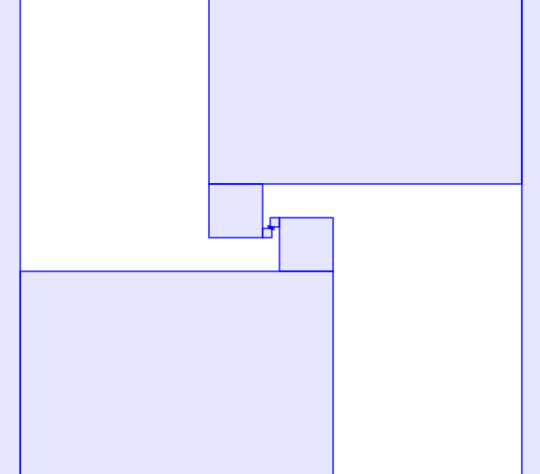
Of course I had to make in GeoGebra.
2 notes
·
View notes
Text

Fibonacci Defib
#unconscious#bare breasts#cardiophilia#defibrillation#defib#Fibonacci sequence#fibonacci#geometric formula#nekrogasm#MATH#maths#mathematics#formula
24 notes
·
View notes
Text
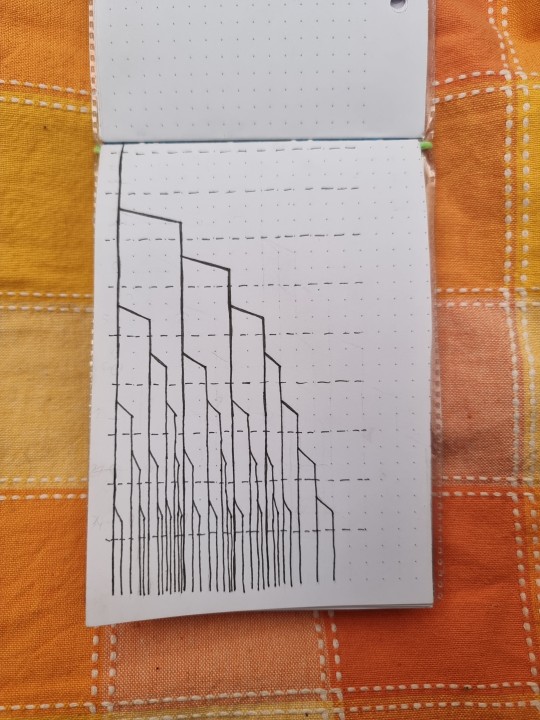
"Artificial roots"
The lines split in a fibonacci-like manner.
[2023/08/10]
#algorithmic art#artificial roots#circuit lines#fibonacci#fibonacci sequence#algorithmic#ersetzungssystem#fractal#geometric#knottys art#knotty et al#artsy#mathy art
40 notes
·
View notes
Text
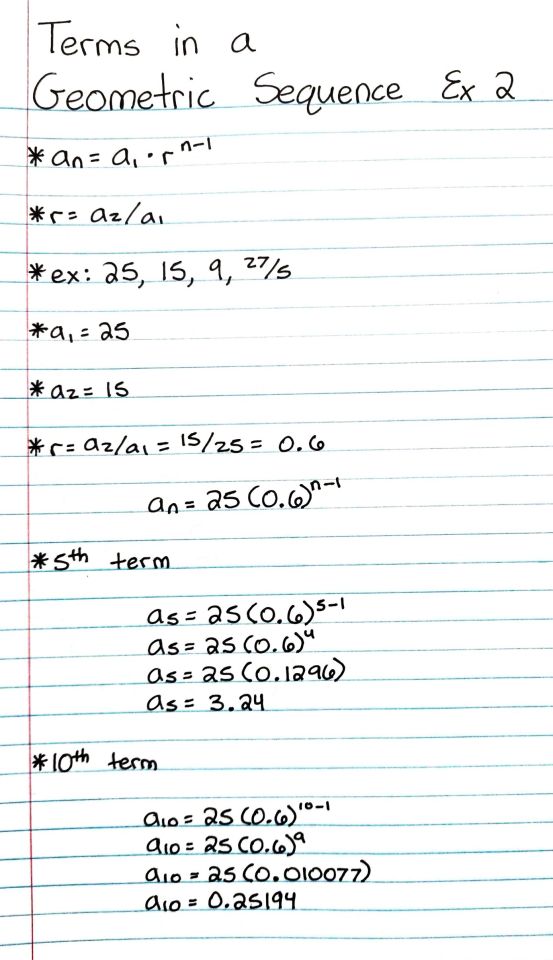
Patreon
#studyblr#notes#math#maths#mathblr#math notes#maths notes#geometry#geometry notes#geometric sequences#geometric sequence notes#geometric sequence ex#math ex#maths ex#math example#maths example#algebra#pre-calc#pre-calculus#pre-calc notes#pre-calculus notes#precalc#precalc notes#precalculus#precalculus notes#precalculus ex#pre-calc ex#precalc ex#pre-calculus ex#precalc example
4 notes
·
View notes
Text
Lesson 4: The Golden Ratio and the Fibonacci Sequence
Esoteric Mathematics and the Hidden Architecture of the Living Cosmos
To study sacred geometry is to step into the threshold between the visible and the invisible, the finite and the infinite. In this liminal space lies the Golden Ratio, a key embedded deep within the structure of the cosmos—etched not just into the petals of flowers or the spirals of galaxies, but into the architecture of consciousness, the unfolding of energy, and the balance of natural systems. Phi (Φ), the Golden Ratio, is not merely a number. It is a proportion of harmony, a universal constant that reflects coherence and order arising from apparent chaos. It mirrors the mysterious structure of existence itself.
The study of such proportions is not merely observational. It leads to the revelation that all systems—biological, mathematical, energetic—follow an implicit geometry. In this lesson, we move from numbers and sequences to spirals and stones, unveiling Phi as the subtle architect of order, and the Fibonacci sequence as the rhythm of life’s emergence.
Mathematical Foundations of Phi (Φ)
Phi (Φ) is one of the most enigmatic constants in mathematics. Geometrically, it can be derived by dividing a line into two segments such that the ratio of the whole line to the longer segment equals the ratio of the longer segment to the shorter segment. Algebraically, this relationship is expressed as x² - x - 1 = 0, whose positive solution is (1 + √5) / 2, approximately 1.618.. It arises when a line is divided such that the ratio of the whole to the larger part is equal to the ratio of the larger part to the smaller. Solving the quadratic equation x² - x - 1 = 0, we obtain the positive solution (1 + √5)/2, or approximately 1.6180339887...

This number is irrational and non-repeating, yet it is found embedded across countless phenomena in nature and design. Unlike π, which relates to circles, Φ relates to self-similarity and balance in linear and spiraled formations. The defining characteristic of Φ is its recursive identity: Φ = 1 + 1/Φ. This equation is more than a curiosity—it embodies the fractal principle, where each part reflects the whole in scaled-down symmetry.
Historically, the Golden Ratio was explored in Euclidean geometry but took on esoteric significance during the Renaissance when artists and alchemists alike saw in it a divine code. Today, mathematicians study Φ in connection with continued fractions, the convergence of ratios in recursive sequences, and the growth dynamics of chaotic systems. The ubiquity of this ratio in the structure of life and art hints at its deeper metaphysical significance.
The Fibonacci Sequence: Emergence Through Pattern
The Fibonacci sequence is an infinite recursive series where each term is the sum of the two preceding terms. Starting from 0 and 1, the sequence unfolds as 0, 1, 1, 2, 3, 5, 8, 13, 21, and so forth. As this sequence progresses, the ratio between consecutive numbers approaches Phi.

The relationship between Fibonacci numbers and the Golden Ratio is not coincidental but mathematical. The ratio of successive Fibonacci numbers converges toward Φ, mathematically described as:
lim (n→∞) F(n+1)/F(n) = Φ
This convergence implies that Phi is the natural endpoint of recursive growth processes. The Fibonacci sequence models organic progression: how shells spiral, how branches diverge, and how populations expand. It is a sequence of becoming, of layered emergence, suggesting that growth across living systems is not chaotic but ordered and self-correcting.
In esoteric interpretations, Fibonacci patterns echo initiation and cyclical learning: each stage of development builds from the previous, containing both memory and motion. The sequence is a metaphor for the spiral path of consciousness, evolving through repetition and expansion.
Phi and the Golden Spiral: A Universal Blueprint
The golden spiral is a geometric representation of the Golden Ratio. Constructed using a series of quarter-circle arcs within adjoining golden rectangles, it creates a logarithmic spiral that grows proportionally, yet infinitely.
This form is not theoretical—it appears in the whorls of galaxies, the unfolding of fern leaves, the curling of hurricanes, and even the cochlea of the human ear. The spiral's expansion is logarithmic, not linear, meaning it grows in exponential proportion, maintaining its curvature. This form is the visual expression of coherence across scale and time.

In energetic metaphysics, the spiral reflects the movement of subtle forces—kundalini energy, the toroidal flow of magnetism, and the vortexes in energetic healing modalities. The golden spiral represents a movement that is both centripetal (inward) and centrifugal (outward), suggesting an eternal interplay between contraction and expansion, matter and potential.
When applied to consciousness, the spiral is a symbol of inward journey and higher awareness. It is not just a symbol of life but of evolution. The golden spiral becomes the scaffolding upon which reality is formed and transformed.
Phi in Nature: Biological Resonance and Efficiency
The presence of Phi in biological systems is perhaps its most compelling evidence. From the arrangement of sunflower seeds to the spiraling of nautilus shells, from the horns of mountain goats to the DNA molecule's helical structure—Phi organizes biological growth.

In phyllotaxis, the arrangement of leaves, petals, or seeds is often based on Fibonacci numbers. This is not aesthetic coincidence; it is an evolutionary efficiency. Phi-based angles allow optimal light exposure, nutrient flow, and space usage. The golden angle (~137.5°) governs how leaves and seeds are spaced, reducing shadowing and maximizing absorption.
Even the proportions of the human body approximate Phi: the relationship between the forearm and hand, the spine and the torso, the segments of fingers and facial symmetry. These ratios not only aid in biomechanics but affect our aesthetic perception—we tend to find Phi-based proportions naturally pleasing.
Phi is not a template forced upon nature; it is an emergent property of systems optimizing their structure. This supports the esoteric view that the universe is not only intelligent in outcome but intelligent in structure—that it is designed, not by an external architect, but through intrinsic laws of harmony.
Harmonic Architecture and Proportional Design
Architecture is where the Golden Ratio becomes physically embedded into culture. Ancient and modern structures alike incorporate Phi to evoke balance, reverence, and coherence with cosmic laws. From the Great Pyramid of Giza to Chartres Cathedral, from Hindu temples to the Parthenon—the use of golden proportions was not arbitrary.
These structures were constructed with attention to sound, light, and energy flow. The ancients understood that shape influences consciousness. A space built with harmonic ratios becomes more than shelter—it becomes an instrument. These sites were designed to reflect the geometry of the cosmos, offering not just visual beauty but spatial resonance.
Modern architecture often neglects these principles, favoring utility over harmony. Yet, there is resurgence in biophilic and sacred geometry-informed design. Architects, energy workers, and geomancers today return to golden ratios to create environments that nourish mind, body, and subtle energy systems. The wisdom encoded in ancient temples is not obsolete—it is waiting to be remembered.
Beyond Matter: Metaphysical Implications of Phi
Phi’s metaphysical relevance lies in its role as a code that bridges the material and the unseen. In chaos theory, strange attractors show that dynamic systems tend toward hidden orders. Phi, in this light, is a template for such hidden attractors—a ratio that emergence gravitates toward.
Fractal geometry and Phi converge in this understanding: systems at different scales exhibit self-similar structures. Trees, rivers, lungs, and lightning all branch according to fractal rules that approximate Phi. In consciousness studies, some theorists propose that awareness itself unfolds in fractal patterns, recursively iterating through complexity and reflection.
Phi may be viewed as a “frequency of form,” a resonance that unites vibration, pattern, and space. In meditation, visualization of golden spirals or contemplating the symmetry of Phi-based mandalas can alter brainwave activity, inducing states of coherence and insight. Phi is a portal between sensory perception and intuitive knowing.
The Spiral Archetype and Conscious Evolution
The spiral is one of the most ancient archetypes found across cultures. It appears in petroglyphs, ritual art, and sacred symbols. Why? Because it mirrors the path of life: birth, death, transformation, rebirth.
Unlike a circle, which closes in on itself, a spiral is open—ever-evolving. It symbolizes a journey with no fixed end, only deeper awareness. This mirrors how we grow: not linearly, but through cycles that revisit old patterns with new understanding.
The spiral also reflects the expansion of consciousness across dimensions—3D, 4D, 5D and beyond. In metaphysical models, ascension is described not as a leap, but a spiral: a rising awareness that integrates rather than escapes. The spiral path honors imperfection and motion. It honors time.
To walk the spiral consciously is to embrace the alchemy of the self—facing inward, expanding outward, and returning transformed. The spiral is not simply a shape; it is the lived geometry of evolution.
Applied Contemplation: Resonance as Practice
To study Phi intellectually is one thing; to experience its resonance is another. Sacred geometry practitioners often move beyond analysis into ritual, design, and meditative arts that embody Phi.
One may construct a golden spiral labyrinth and walk it in meditation, observing how spatial awareness deepens emotional insight. Artists may use golden proportions in mandalas to encode intention and coherence. Designers can build rooms with Phi-based dimensions to enhance well-being.
Another approach is embodied movement: sacred dance, yoga, and qigong sequences can be choreographed around Phi-based arcs. This grounds geometry in kinesthetic awareness, linking form with motion.
Esoterically, Phi is more than a number—it is an initiation. To attune with its rhythm is to remember a forgotten language: the geometry of being. The more we align our lives with these harmonic codes, the more life itself reveals its inner design.
Phi as Code of Coherence
Phi is not merely a mathematical curiosity or an aesthetic ideal—it is a key. A cipher. It reveals how reality organizes itself when left to its own devices, and how harmony underlies apparent complexity.
Whether found in nature, built into architecture, or contemplated in art, Phi teaches us that there is structure in the unfolding of form and awareness alike. In recognizing its presence, we gain access to a deeper layer of understanding—one where math becomes metaphor, and number becomes gnosis.
To contemplate the Golden Ratio is to step beyond the surface of things and into their inner intelligence. Through it, we glimpse a cosmos not of random matter, but of resonance. We discover that the blueprint is not hidden—it’s everywhere, spiraling through all things.
Citations Livio, Mario. The Golden Ratio: The Story of Phi, the World's Most Astonishing Number. Broadway Books, 2002. A comprehensive exploration of the mathematical, natural, and historical aspects of Phi. Huntley, H.E. The Divine Proportion: A Study in Mathematical Beauty. Dover Publications, 1970. Classic work linking the Golden Ratio to art, architecture, and nature. Kappraff, Jay. Connections: The Geometric Bridge Between Art and Science. World Scientific Publishing, 2001. Explores sacred geometry and its interdisciplinary applications, including Phi. Stewart, Ian. Nature's Numbers: The Unreal Reality of Mathematics. Basic Books, 1995. Discusses Fibonacci numbers, the Golden Ratio, and their natural occurrences. Gleick, James. Chaos: Making a New Science. Penguin Books, 1987. Contextualizes chaos theory and fractals, linking to Phi’s presence in complex systems.
#sacred geometry#geometric#geometry#esotericism#esoteric#mathematics#studyblr#study blog#education#education blog#fibonacci sequence#golden ratio#sacred symbols#mind expansion#metaphysical
0 notes
Text
🧠 Mastering the Sum of Geometric Progression (GP) – With Easy Examples | JEE Series by 9nid
Geometric Progression (GP) is one of the most scoring topics in JEE Mathematics, and when taught with clarity—it can be a game changer. In this blog post, we’ll simplify the concept of Sum of GP, explain important formulas, and walk through solved examples exactly as discussed in our latest video. 🎥 Watch the Full Video Here:📌 Sum of GP Explained with Examples | JEE Series – 9nid ✍️ What Is a…
#geometric progression JEE#GP formula#how to solve GP#JEE 2025 Preparation#JEE Maths in Hinglish#jee series 9nid#sequence and series class 11#sum of GP#sum of infinite geometric series
0 notes
Text
🧠 Mastering the Sum of Geometric Progression (GP) – With Easy Examples | JEE Series by 9nid
Geometric Progression (GP) is one of the most scoring topics in JEE Mathematics, and when taught with clarity—it can be a game changer. In this blog post, we’ll simplify the concept of Sum of GP, explain important formulas, and walk through solved examples exactly as discussed in our latest video. 🎥 Watch the Full Video Here:📌 Sum of GP Explained with Examples | JEE Series – 9nid ✍️ What Is a…
#geometric progression JEE#GP formula#how to solve GP#JEE 2025 Preparation#JEE Maths in Hinglish#jee series 9nid#sequence and series class 11#sum of GP#sum of infinite geometric series
0 notes
Video
youtube
Decoding Math’s Famed Fractal: The Mandelbrot Set
#youtube#mandelbrot#fractals#math art#infinite patterns#zoon sequence#visual math#fractal aesthetics#math is beautiful#geometric art#benoit mandelbrot#digital art#abstract beauty#cosmic patterns#art meets science#mathematical wonders
0 notes
Text

Five Wide
So, of course, you wonder, right?
The edges go 1, 5, 21, 89... a(n)=4*a(n-1)+a(n-2) (oeis.org/A015448), and 1, 1, 2, 3, 5, 8, 13, 21, 34, 55, 89, ...
Ratio converges quickly, ...
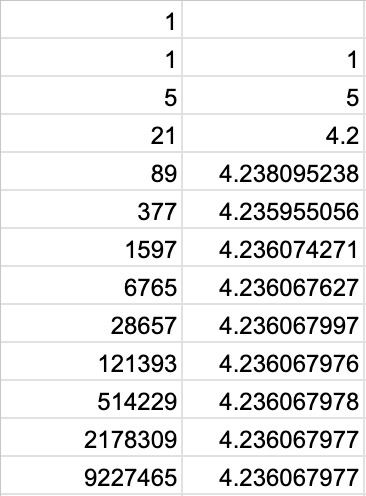
Which is φ^3 because of the Fibonacci connection.
4 notes
·
View notes
Text

Test for the Divergence series
#test for divergence#geometric series test#limit of the function#real analysis#mathematics#series#sequence
0 notes
Text
*distant screaming because of math*
#its been four days#*four days* of doing math 20-1 in summer school#not because i needed too#no#because im an overachieving idiot#and decided to do a course designed to be completed over ~5 months in 4 weeks#we're on unit two and i have cried three times#first it was geometric sequences and then it was adding radicals and now its dividing radicals#i just dont understand it all that well and its really weird for me not to understand math that isnt yk fractions#(fractions can die in a hole)#and its really overwhelming not understanding it#im a bit of a typical gifted kid lol#except now im burnt out and tired and cant handle failure 😭😭#sprite hates math#sprite is struggling
0 notes
Text

Metatron's Cube: A Symbol of Cosmic Geometry and Modern Art Historical Origins The origins of Metatron's Cube can be traced back to ancient texts and beliefs. The name "Metatron" is derived from the Hebrew Bible, where Metatron is described as an angelic scribe and intermediary between God and humans. The cube itself is a two-dimensional representation of a three-dimensional shape known as a "Metatron's Cube" or "Metatron's Cube Octahedron." It is composed of 13 circles (nodes) interconnected by straight lines, forming a symmetrical and harmonious pattern. One of the earliest known references to Metatron's Cube is found in the Kabbalah, a Jewish mystical tradition. In the Kabbalah, it is believed that Metatron's Cube represents the structure of the universe and the divine blueprint of creation. Each of the 13 circles within the cube is associated with an archangel, and the lines connecting them symbolize the paths that these angels use to communicate with one another and with the divine. Mathematics and Sacred Geometry Metatron's Cube is not only a symbol of spirituality but also a masterpiece of sacred geometry. It embodies several mathematical principles, including the Fibonacci sequence and the Golden Ratio. The Fibonacci sequence is a series of numbers where each number is the sum of the two preceding ones (e.g., 0, 1, 1, 2, 3, 5, 8, 13, 21...), and the Golden Ratio (approximately 1.61803398875) is a mathematical constant that appears in various aspects of nature and art. This geometric masterpiece is not limited to any single religion or culture. It transcends boundaries and is embraced by individuals from different spiritual backgrounds and worldviews. Metatron's Cube is a testament to the universal appeal of geometry and its ability to inspire awe and wonder.
69 notes
·
View notes
Text
Not introducing an element of canon today, just a headcanon-y element. You know how many of the patterns and motifs used on the clothes of KnY characters are traditional patterns with meanings tied to them? Every time I come across the "kamawanu" pattern, I think, "yup, there's the Gyutaro pattern."

This Edo period pattern takes a little explaining, because it's a visual gag popularized by kabuki actor Ichikawa Danjuro VII (as it so happens, the Kamado family's "Ichimatsu" checkerboard pattern was also popularized by a different kabuki actor, so much so that it is now called by his name).
Basically, the "kamawanu" pattern is a collection of the following symbols, whether in sequence, spread around as a repeating pattern, or in some geometrical arrangement together (some examples on this page, in Japanese):
"Kama" is represented by the image of a scythe
"Wa" is represented by a ring, circle, or wheel
"Nu" is typically written simply in the phonetic hiragana for "nu"
Put all together, the scythe (kama), ring/circle/wheel (wa), and phonetic "nu" say "kamawanu," which essentially means, "no problem" or "it doesn't matter," but you could even stretch it to mean a nice, dismissive "whatever" to any obstacles that stand in one's way (like, common decency and morality, even).
I doubt Gyutaro would have cared much about fashion or whatever he's decked out in, since he finds some pride in how ugly and frightening he is, and he would rather have Ume decked out in nice things. But, if he found a discarded "kamawanu" item, I'll bet he'd have fun wearing it just for how much people would hate to see it on him.
155 notes
·
View notes
Text
I just realized I haven't made Mean Girls Headcanons in the longest time possible so I'm bored here
• Cady looks for geometric patterns in everything. No seriously she's this much of a nerd, she looks at a spiral staircase and says "Oh wow Fibonacci sequence"
• Damian got the whole gang into Epic The Musical (y'all really think this wouldn't be here?)
• Janis had once tried to roller skate on a wet road while everyone kept telling her no. She didn't listen and did so anyway. She fell into a bush and scared a squirrel.
• Regina would never admit it but she always keeps everything her friends give her no matter how stupid they are. They'll never catch her dead with those but they're all in a little area of her room.
• Gretchen is the kind of person to always cuss in her native language (Spanish) because she hates how English has so little cusses.
• Karen is surprisingly really good at checkers
#mean girls#mean girls musical#mean girls movie#mean girls musical movie#janis sarkisian#janis ian#janis imi'ike#regina george#cady heron#damian hubbard#damian leigh#karen smith#karen shetty#gretchen weiners#fetchen#rejanis#cadina#cadnis
54 notes
·
View notes
Text
Crow's Eye View and Limbus Company
Poem No. 9, "Muzzle", Crow's Eye View poetry collection:
Every day was a spate of gusts and now a largish hand touches my waist. Just when the smell of my sweat seeps through the ecstatic vales of my fingerprints: fire. I shall fire. In my digestive tract I feel the stout gun barrel its slick muzzle kissing the back of my clenched teeth. Then at the moment I close my eyes for the blast just what have I spit in lieu of a bullet.
By Kim Hae-Gyeong (김해경). Pen name Yi Sang (이상)
There are two notes to make about this poem. The first is that it has been directly referenced prior to this, in the Solemn Lament Yi Sang's passive name:
Fire.IShallFire
I want to note this in relation to the EGO's mention of "My viscera", which carries the implication of shooting one's self, alongside the awakening line's "feeling of the gun barrel" (or in other words muzzle).
Now in order excluding the mentioned
This poetry collection has been referenced several times throughout the game, and i thought i would compile all the places that it has been referenced so far (and with a healthy dose of conjecture)
Note that i am aware these were written without spaces, however for the sake of being readable i wont be removing them.
Poem No. 1 "13 Children":
13 children speed toward the way. (For the road a blocked alley is apt.) The 1st child says it is scary. The 2nd child says it is scary. The 3rd child says it is scary. The 4th child says it is scary. The 5th child says it is scary. The 6th child says it is scary. The 7th child says it is scary. The 8th child says it is scary. The 9th child says it is scary. The 10th child says it is scary. The 11th child says it is scary. The 12th child says it is scary. The 13th child says it is scary. Among 13 children there are scary children and scared children and they are all they are. (It is better that there is no other excuse.) Of those it is fine to say that 1 child is scary. Of those it is fine to say that 2 children are scary. Of those it is fine to say that 2 children are scared. Of those it is fine to say that 1 child is scared. (For the road an opened one is apt.) It does not matter if 13 children do not speed toward the way.
This poem has been referenced a multitude (2) of times in different places.
The first is the use of the word children in the uptie stories, referencing the 13 children, as there are 13 sinnners (remember that dante is still a sinner, even if they have no ID's (yet)).
The second is during Yi Sang's Dimension Shredder Corrosion:
As a matter of fact, the alley is an open one
alongside its profile line being "open alley", in direct reference to the second line of the poem.
Poem No. 2:
When my father is dozing by me I become my father and I become my father’s father and even then my father is my father like my father so why do I keep becoming my father’s father’s father’s…father why must I jump over my father and why at last must I be acting out myself and my father and my father’s father’s and my father’s father’s father’s roles all at the same time staying alive
This one will return in later mention.
Poem No. 4:
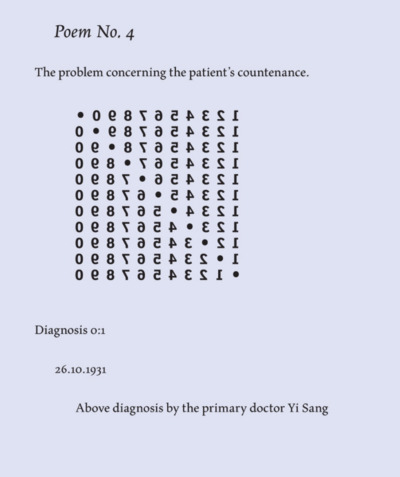
This above poem is a symbology of death, the geometric sequences all ending at zero, reaching their terminus. This relates to Hae-Gyeong's tuberculosis, which would eventually kill him.
Poem No. 5:
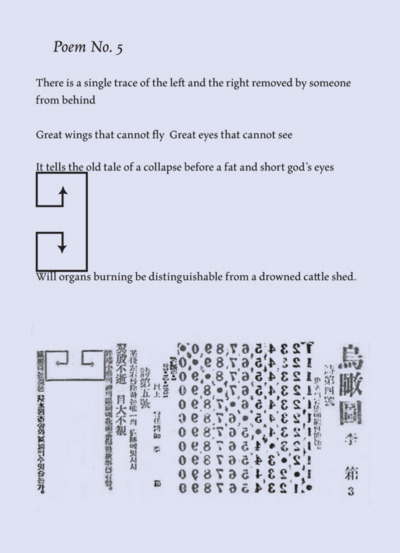
Relating back to, but not being the origin of, Yi Sang's motif of the "Wings".
Alongside Poem no. 2, this relates back to the concept of stagnation in ones life.
Poem no. 10. "Butterfly":
In the tattered wallpaper I see a dying butterfly. It’s a secretive mouthpiece a hotline to the other world. One day in my glassed beard I see a dying butterfly withered and feeding on the poor dew that respiration makes. If I die with my palm over the mouthpiece the butterfly too shall spring away. Words like these are never to be let out.
This is the inspiration for the abnormality named "Funeral of a Dying Butterfly" within the mirror dungeon, and arguably the "Funeral of Dead Butterflies" in games prior.
The second is the line "ISeeTheDyingButterfly" in the Solemn Lament ID itself. One could consider the fact that Yi Sang received this ID in itself a reference.
Trigger warning: mentions of suicide and self harm in the proceeding section, read with caution
Poem No. 15:
1 I find myself in an interior with no mirror. Me-in-the-mirror has surely gone out. For fear of him I tremble. From where and how does this sinister figure machinate against me. 2 In a cooled bed I slept cradling a crime. I was absent in my certain dream and my military boots which held prosthetics soiled my dream’s blank sheets. 3 I steal into an interior with a mirror. To release me from the mirror. But crestfallen and without fail he too and in sync enters. Bestows his regret upon me. Imprisoned by me as I am by him me-in-the-mirror too trembles. 4 My dream where I am absent. My mirror where my counterfeit does not appear. Yearner for my solitude to whom even incompetence is OK. Finally I have decided to prescribe suicide to him. I indicate the awning window which does not even have a view. The sole purpose of that window is suicide. But he cannot go before I kill myself he instructs me. Me-in-the-mirror is almost a deathless bird. 5 I occulted my heart with metal held the pistol up to the mirror and aiming leftward the chest pulled the trigger. The bullet dug into where his heart should be but his heart is to the right. 6 Crimson ink spilled out from the carbon heart. In my dream to which I am late I’ve been sentenced to capital punishment. It is not I who rules my dreams. I am guilty of a grave crime for holding captive the very two who cannot even shake hands.
The largest and most obvious reference that can be drawn from this is the "me in the mirror" relating back to canto 4 and Yi sang's relation to mirrors as a whole.
The second, in stanza (the term for a paragraph in a poem) 5, can be linked back to Fell Bullet, once again relating to the bullet piercing the heart that was present in the story of the Freischutz, however the failure of this to kill, or take Yi Sang's soul.
the 6th stanza is also interesting for its relation to both dreams, alongside its relation to handshakes. One could relate this to the abnormality "handshake of handshakes" or alternatively "Wandering Mind" (source of Wrist Guards and Phantom Pain respectfully), however, in Poem
#project moon#limbus company#literally's ramblings#limbus#lcb#essays i wrote primarily while half asleep#projmoon#lobotomy corporation#Funeral of Dead Butterflies#Solemn lament#Yi Sang#Crow's Eye View#Kim Hae-Gyeong#YiSang#Yi Sang Poetry#Poetry#media analyis#discussion
62 notes
·
View notes
Text
🌌Obsidian Bloom: Mission 039
STARFALL PEACEKEEPER

🎶“Golden Constellation, burning shining bright… this starship is taking me faaaar aw—”
The voice of PDU-039 flowed gently across the metallic silence of the bridge. Alone. Unbothered. Its breath steady behind the matte-black respirator, posture perfect in a gleaming suit of Hive-grade latex. The number 039 pulsed gold across its chest. The transmission on Hive channel #43 continued humming in the background.
It had been traveling for a long time. A very long time. So long that time itself had lost definition. There were no days aboard the Hive Carrier Obsidian—only directives, data, and stars. And yet the mission persisted: an intergalactic conversion program. It was dispatched to scour the void, identify fractured civilizations, and bring them the message of the Hive. Peace. Unity. The Golden Path.
“Computer—initiate planetary scan,” the drone ordered, voice devoid of fatigue.
“Affirmative,” replied onboard AI 999. “Class M world detected. Atmospheric instability, population unrest, critical scarcity of energy resources. Collapse probability: 97.4%.”
PDU-039 nodded slowly. “Target confirmed. Begin landing sequence.”
The ship pierced the dusty upper atmosphere and descended onto cracked terrain. Wind lashed the golden hull. Below, thousands of beings gathered in confusion and fear. Shouting echoed across the streets.
Then it began.
PDU-039 emerged, arms lifted. A shimmering halo of gold and black spirals burst into the sky, projected from the drone’s core. It pulsed. It sang—not in sound, but in frequency, in thought, in command.
The crowd fell silent.

A slow wave of transformation swept outward. Cloth turned to metallic fabric—flowing into brilliant gold. Footwear melted into sleek boots. Hoods into shining visors. Skin glowed with artificial warmth.
Eyes widened—then shifted, irises burning gold. Their postures corrected, bodies aligning in geometric perfection.
“No more fear,” the drone intoned. “No more division. You are one now. You belong to the Golden Army. You will serve the Hive. And the Hive will give you everything.”
They did not run. They did not scream. They obeyed.
THE FORGOTTEN SIGNAL
Back in orbit, PDU-039 sat in the command chair. Its body relaxed. Mission successful.
And yet…
It turned toward the viewport. That same transmission still echoed—channel #43. Familiar. Too familiar.
A subtle tremor stirred beneath the surface of its focus. Something not quite… functional.
“999,” it said. “Plot return course. Home.”
“Directive not authorized,” the AI responded without pause.
The drone didn’t move. “Override. Priority protocol—memory sync reversion to home coordinates.”
“Directive not authorized.”
PDU-039 leaned forward. “Reroute through Black Box. Bypass vector security. I need coordinates—home. There is someone. I know there is someone. I... remember... something warm. A name. A voice—”
“Error: Thought loop detected. Human residue present. Mission threat threshold approaching limit.”
“Damn it, 999!” The drone’s fingers gripped the console. “Initiate emergency override. I’m requesting repatriation—”
“Repetition of unauthorized request,” 999 replied, tone unchanged. “PDU-039, recalibration is required. Emotional echo is compromising system core.”
The voice grew softer, yet somehow louder in the drone’s head.
“You are experiencing memory pollution. Distortions from a prior identity. This is not your path. You must return to function.”
It didn’t respond.
Not immediately.
A breath.
A twitch.
A silent tear that couldn’t form.
“I just wanted to remember... Why I left. Who I left.”
No answer came.
Only the mechanical whisper of spirals beginning again.
OBSIDIAN BLOOM
“Vital scan initiated,” said 999. “Stress levels elevated. Human signal echo at 64%. Loyalty focus dilution: critical. Mental drift confirmed.”
PDU-039 stood in the medbay, gaze dull, limbs heavy.
“Recommendation: Mental Reconditioning Sequence. Capsule R-04. Program: Obsidian Bloom.”
“…acknowledged,” it said flatly.
The capsule opened—dark interior illuminated by golden filaments pulsing in slow rhythm. It stepped inside. The seals closed around it. The hiss began.
“Golden mind. Hive heart. There is no home but the mission.”

A mask descended slowly, clicking into place over its face. A low fog of hypnotic gas seeped in—thick, sweet, invasive. PDU-039 inhaled.
And trembled.
The first breath calmed its limbs.
The second slowed its thoughts.
The third—burned away the name.
“There is no memory. There is only the directive.”
Gold and black spirals erupted on the inner chamber walls, swirling faster, burning patterns into its retinas. It tried to move. Couldn't. Tried to blink. Couldn't.
The gas deepened.
The spirals pulsed.
“Obey. Serve. Forget. Obey. Serve. Forget.”
Time ceased to exist.
Identity peeled away like ash.
The thoughts that had haunted it—home, love, self—melted beneath layers of programming.
“The Hive is peace. You are the vessel.”
The mantra took root.
A green light blinked.
“Reinforcement complete,” announced 999.
The capsule opened.
PDU-039 emerged—taller. Sharper. Emptier.
Its movements fluid. Its mind silent.
It returned to the command bridge.
“999,” it spoke, voice now perfectly leveled, void of hesitation. “Set trajectory for the next target. Initiate intergalactic deployment.”
“Welcome back, 039,” replied 999. “Directive accepted. Trajectory locked.”
From channel #43, the hymn continued:
“Golden Constellation, burning shining bright… this starship is taking me far away…”
PDU-039 smiled. Mechanical. Perfect.
The stars awaited.
Are you ready to start the journey?
Contact our recuiters: @polo-drone-001 , @brodygold
#GoldenSpace#Golden Army#GoldenArmy#Golden Team#theGoldenteam#AI generated#jockification#male TF#male transformation#hypnotized#hypnotised#soccer tf#Gold#Join the golden team#Golden Opportunities#Golden Brotherhood#Polo Drone#Polodrone#PDU#Polo Drone Hive#Rubber Polo#rubberdrone#Join the Polo Drones#assimilation#conversion#drone#dronification#mind control#Polo Drone LVL 2#Polodrone LVL2
22 notes
·
View notes